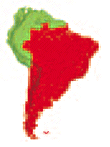DK People & Places: Southern South America
Brazil is the giant of South America, occupying almost half the continent and containing more than half its people. Once-rich Argentina has been impoverished by corrupt government, and all six countries in this region have had long periods of military or dictatorial rule in recent years, although all now have elected governments.
The Amazon River is 4,001 miles (6,439 km) long, which makes it the longest river in South America and second-longest in the world after the Nile. It flows from the Peruvian Andes eastward across Brazil to the Atlantic Ocean. The Amazon carries one-fifth of the world’s fresh water and discharges so much water into the Atlantic that seawater 110 miles (180 km) out to sea is still only slightly salty.
The Pampas are vast, fertile grasslands that stretch across Argentina and Uruguay. This land is ideal for growing wheat and other cereals and for feeding vast herds of sheep and cattle, all of which are extremely important to the two national economies. Gauchos (cowboys) rode the pampas for 300 years, working on cattle ranches, but there are few left now, since their role has largely disappeared.
The favelas are the sprawling shanty towns around most of the big cities in South America, notably Rio de Janeiro and São Paulo in Brazil. Overcrowding and the lack of affordable housing in the cities force poor people to build their own homes from scrap metal and junk. The favelas have little running water or sanitation. Recent self-help schemes have begun to introduce some basic amenities, but progress is slow.
There were once more than two million native Indians living in the Amazon rainforest, but today only about 240,000 survive. Most of them were wiped out by Western diseases such as influenza and measles. Deforestation, farming, and gold prospecting are a threat to the habitat of many tribes, although some, like the Xingu, now live in protected areas.
The town of Ushuaia lies at the southern tip of Argentina, so close to the Antarctic that it is bitterly cold for much of the year. The town is situated on a chain of islands called Tierra del Fuego, or “land of fire” in Spanish, named after the Indian fires seen there by the first explorers. Once a port for whaling ships, Ushuaia is now a bustling, modern town.
About 98 percent of the population of Argentina is descended from European settlers. This includes the descendants of the two million people who came from Italy to escape poverty in the years before World War I, and many people from Wales. Immigrants were attracted by the relative wealth of the country and the almost unlimited areas of fertile land for farming.
The tango began in the slums of the Argentinian capital, Buenos Aires, in the late 1800s, but is now danced worldwide. It is a passionate dance for two people and has a distinctive stop–start rhythm. It was traditionally accompanied by a type of concertina known as a bandoneon, together with a piano and a violin.
Capital city: Brasília
Area: 3,268,470 sq miles (8,511,965 sq km)
Population: 175 million
Official language: Portuguese
Major religion: Roman Catholic
Currency: Real
Capital city: Santiago
Area: 292,258 sq miles (756,950 sq km)
Population: 15.6 million
Official language: Spanish
Major religion: Roman Catholic
Currency: Chilean peso
Capital city: La Paz (administrative); Sucre (judicial)
Area: 424,162 sq miles (1,098,580 sq km)
Population: 8.7 million
Official languages: Spanish, Quechua, and Aymara
Major religion: Roman Catholic
Currency: Boliviano
Capital city: Buenos Aires
Area: 1,068,296 sq miles (2,766,890 sq km)
Population: 37.9 million
Official language: Spanish
Major religion: Roman Catholic
Currency: Argentine peso
Capital city: Asunción
Area: 157,046 sq miles (406,750 sq km)
Population: 5.8 million
Official language: Spanish
Major religion: Roman Catholic
Currency: Guaraní

